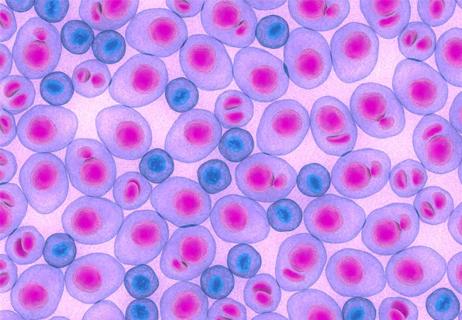Study demonstrates ability to reduce patients’ reliance on phlebotomies to stabilize hematocrit levels

A hallmark of the blood disorder polycythemia vera (PV) is production of excess blood cells, which can lead to blood clots. Patients with this condition are burdened with regular phlebotomies to lower their hematocrit. However, these procedures leave patients iron deficient, often resulting in fatigue, joint aches, lack of ability to focus and restless leg syndrome.
Advertisement
Cleveland Clinic is a non-profit academic medical center. Advertising on our site helps support our mission. We do not endorse non-Cleveland Clinic products or services. Policy
In a new study published in the New England Journal of Medicine, researchers demonstrated that treatment with the injectable hepcidin mimetic rusfertide consistently helped maintain safer hematocrit rates while reducing erythrocyte levels in patients with PV.
High hematocrit levels increase the risk of thrombosis. That’s why traditionally, patients with PV who are 60 and older or those with a previous thromboembolic event were treated with cytoreductive therapies as well as anti-platelet therapies and phlebotomies.
Many patients require numerous phlebotomies to maintain hematocrit <45%. Additionally, repeat phlebotomies may exacerbate iron deficiency, and then stop being an option for some patients.
Previously tested medications could decrease the risk of thromboembolic events but could not treat the underlying PV disease or high hematocrit levels.
“There have been debates in the field about whether phlebotomy alone was the best course for these patients and whether we should expose patients to medication,” explains Aaron Gerds, MD, a hematologist/oncologist at Cleveland Clinic Cancer Institute. “Initial trials of polycythemia vera laid the groundwork for what we know today, but there were still gaps in our knowledge that we wanted to resolve.”
Researchers already knew that rusfertide could help to regulate iron levels in the body. In pre-clinical trials, hepcidin-mimetics like rusfertide lowered hemoglobin levels as well as iron overload in murine models. Later, a phase 1 study of healthy male volunteers receiving rusfertide led to dose-dependent reductions in serum iron levels. Based on this data, the researchers embarked on the REVIVE study, a phase 2 research endeavor to evaluate the safety and efficacy of rusfertide in patients with PV in regular need of phlebotomies.
Advertisement
“Rusfertide harnesses the body's own iron-regulation through hefcitin,” explains Dr. Gerds. “This medication acts like hefcitin and ‘tricks’ the body into thinking it’s iron deficient.”
In a 28-week, open-label, dose-finding study, 70 study participants were enrolled in part 1 of the study. In part 2 of the study, participants were randomized to either receive rusfertide or placebo over a 12-week period. The primary endpoint was based on the number of study participants who achieved hematocrit control, without the need for phlebotomy. Between October 2019 and March 2022, 37 participants were treated with phlebotomy alone and 33 with phlebotomy and cytoreductive therapy.
The study data revealed that rusfertide decreased reliance on phlebotomy by a demonstrable amount. In part 1 of the study, the mean phlebotomy rate decreased from 8.1 times a year prior to rusfertide administration to 0.6 a year. The medication quickly reduced or eliminated the need for phlebotomy between weeks 1-29.
During this time, patients experienced an improvement in serum ferritin as well as transferrin saturation, which indicated that iron stores were being redistributed in the body. Study participants also experienced lessening of troubles with concentration, which is a side effect thought to be caused by iron deficiency.
“This is an exciting new development,” says Dr. Gerds. “We’ve only had two FDA-approved medications for treating PV and neither of those lower risk of blood clots.”
Although the study results are small, they are quite promising. “This represents an important step in the treatment of PV with a different mechanism of action for controlling both erythrosytosis as well as PV symptoms,” says Dr. Gerds.
Advertisement
A phase 3 trial is planned to validate the phase 2 study findings and to more definitively assess improvements in patients’ quality of life. There are still many unanswered questions, such as how to curb disease progression.
These findings may have implications for the treatment of other blood disorders. In the future, for example, the researchers hope to study whether hepcidin can free patients with myelofibrosis from the need for transfusions.
Advertisement
Advertisement

What’s coming up at ASH and beyond

Researchers Assess Real-Life Experiences of Patients Treated Outside of Clinical Trials

Early, individualized diagnosis and comprehensive management key to preserving fertility

Key considerations when diagnosing and managing severe hyponatremia

First-in-human phase 1 trial induced loss of function in gene that codes for ANGPTL3

Treatment strategies require understanding of pathomechanisms

First-in-human trials of CRISPR-Cas12a gene editing demonstrate safety and meaningful event-free survival

Strategies and risk models are evolving for this asymptomatic condition